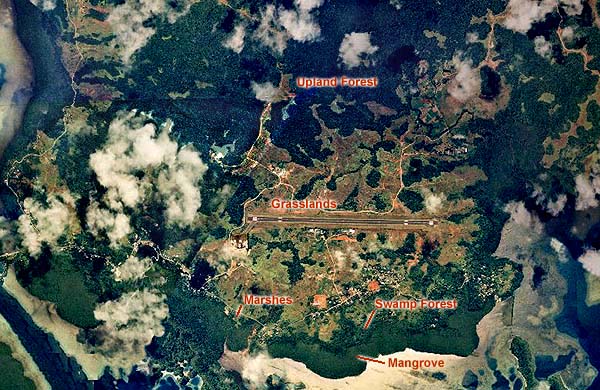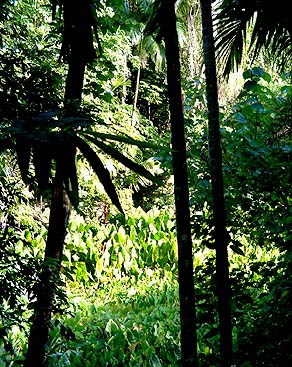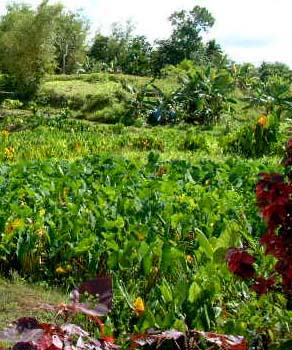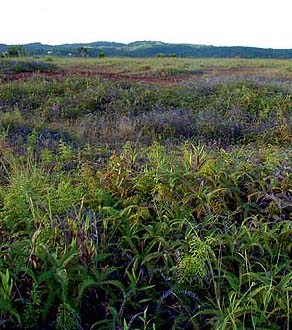 |
 |
 |
 |
||||
|
|
|
|
|
|
|
|
|
|
|
|||||||
|
|
|
|
|
|
“There are Palauan names for different areas," Tarita Holm tells us. "We do have a lot of different vegetation types, or different habitat types, and they all pretty much have their own names. When we start at the very bottom, we usually have mangroves along the edge, which is called okeburs. And then as we move up, normally we have some kind of swamp forest type, which is called omeklochel."
|
||
|
|
||
“A swamp forest is a group of trees that love very wet and inundated soils. You have usually a lot of roots coming up. We also used swamp forests for cultivation of taro, but it was a lot more difficult because you have to do a lot more clearing in a forest than in a marsh. But there is more swamp forest than marsh as a vegetation type in Palau, there are a lot more swamp forests. They are very important ecologically, but in terms of their cultural aspect, I think they were kind of a reserve for areas to plant taro. “And then you sometimes have kind of a marsh area, freshwater or saltwater marsh area, and that is referred to as dechel, and dechel is traditionally where we have our taro patches. We would clear out the native fragmities and things like that and plant taro in those freshwater marsh areas."
|
|
|
“The freshwater marshes are sometimes along streams, but not necessarily, not always. There are bits and pieces of marsh areas that have no streams near them, so probably they have a spring somewhere. Marshes are probably Palau’s most endangered vegetation type, because there is very little of it—naturally there is very little marsh vegetation, but it’s also very heavily used for cultivation of taro, hence there’s less and less. I think on Babeldaob about 3% of the island is categorized as freshwater marsh. And that includes the areas that are cultivated. “Marshes usually have different grasses. There’s only a handful of plants that grow in the marsh areas, so it’s not highly diverse in terms of its plants, but it does provide homes to a lot of different wetland bird species, like the duck and the swamp hen."
|
|
|
|
|
“And then moving upwards we would probably have some grasslands. The grasslands are usually referred to as ked. They are very diverse, with a lot of different components. You’ll have grasslands that have mostly ferns, mat ferns, or you’ll have grasslands that are dominated by pandanus or shrubs. So there is the generic name, and there is a bunch of different components that can be part of any area called 'grassland'."
|
||
| |
||
“The terraces are mostly found on grasslands. I think they’ve definitely been altered—they must have been cleared and formed in that way. But in terms of the vegetation, I would think the vegetation is very much how it would have been originally. The same things likely grew up again after they had cleared for terracing. “The terraces are pretty much a mystery still. No one really has a solid theory as to why Palauans did that—why there were terraces, what the purpose was. Was it for defense purposes? Did it have something to do with their strategic, warfare, or did it have something to do with agriculture? There are a lot of different theories going around, but nobody’s really sure.”
|
|
|
“Finally there are the upland forests, which are categorized as oreomel. They are very diverse. Upland forest is kind of the generic term given for it, but just like with the grasslands, there are so many different components that comprise the upland forests. "There are some trees that are only found on the East side of Babeldaob, or the West side of Babeldaob. So that composition of the upland forest really varies greatly. And age makes a difference in the composition. A study recently found that the old growth forests are actually less diverse than the newer ones. "We don’t have any poisonone sea snake (mengerénger), not on land. None of our land snakes are poisonous. And because of that, our forests are pretty mild, they are not very dangerous." |
|
|
|
"These are the major vegetation types we have," Tarita concludes. And as vegetation is so closely linked to weather and climate, we next turn our attention to winds.
|
||
|
|
||
|
|
|
|
|
|

|
| Airai Home | Map Library | Site Map | Pacific Worlds Home |
|
|
|
|

|
|
|
|||
| Copyright 2003 Pacific Worlds & Associates • Usage Policy • Webmaster |
|||







